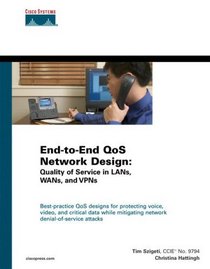Search -
End-to-End QoS Network Design : Quality of Service in LANs, WANs, and VPNs
EndtoEnd QoS Network Design Quality of Service in LANs WANs and VPNs
Author:
Best-practice QoS designs for protecting voice, video, and critical data while mitigating network denial-of-service attacks
Author:
Best-practice QoS designs for protecting voice, video, and critical data while mitigating network denial-of-service attacks
- Understand the service-level requirements of voice, video, and data applications
- Examine strategic QoS best practices, including Scavenger-class QoS tactics for DoS/worm mitigation
- Learn about QoS too... more »
ISBN-13: 9781587051760
ISBN-10: 1587051761
Publication Date: 11/9/2004
Pages: 768
Rating: ?
ISBN-10: 1587051761
Publication Date: 11/9/2004
Pages: 768
Rating: ?
0 stars, based on 0 rating
Genres:
- Computers & Technology >> Certification >> Publisher >> Cisco
- Computers & Technology >> Certification >> Subjects >> Networking
- Computers & Technology >> Certification >> General
- Computers & Technology >> Networking & Cloud Computing >> Networks, Protocols & APIs >> LAN
- Computers & Technology >> Networking & Cloud Computing >> Networks, Protocols & APIs >> Networks
- Computers & Technology >> Networking & Cloud Computing >> Networks, Protocols & APIs >> General
- Computers & Technology >> General




